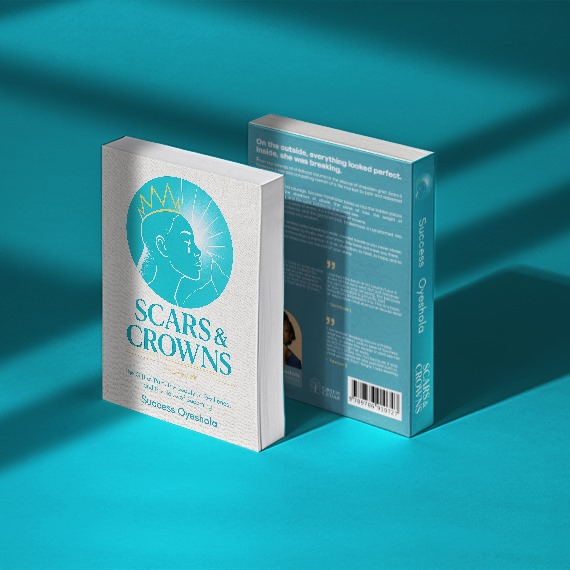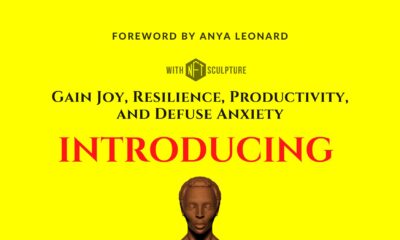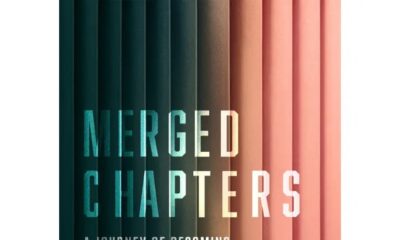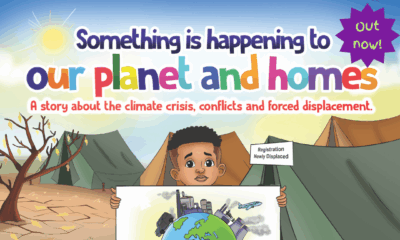Features
BN Book Excerpt: Scars & Crowns by Success Oyeshola

I was six the first time I learned how to swallow a scream.
It wasn’t a lesson anyone sat me down to teach, and there were no instructions, just a moment where my body realised that making a sound would draw more trouble than silence. So, I didn’t cry, I tucked the noise behind my ribs and let the quiet do the bleeding.
Silence became my second skin; not the peaceful kind, the choking kind that sits inside your throat like a malaria tablet refusing to go down. And because life doesn’t pause to ask how you’re holding up, I learned to perform, to show up, to smile when I was torn in seven invisible places. Adults clapped for how “well-behaved” I was. They applauded how “mature” and “strong” I seemed. No one told them that strength can also be a symptom of survival.
My childhood was a collage of contradictions; noise outside, quiet inside. I grew up being the trophy child, the “good girl,” the child who didn’t give anyone trouble. But it wasn’t goodness; it was fear stitched into obedience. It was a little girl trying so hard not to be a burden that she disappeared in plain sight.
You’d think the body forgets pain as it grows, nahh, it doesn’t. It just gets better at disguising it. By the time I hit my twenties, I had mastered the art of high-functioning brokenness. On the outside, I had become the woman people called when they needed help, clarity, or strength. Inside, I was still the six-year-old holding her breath, praying no one would notice the cracks.
And people rarely do. The world loves the version of you that keeps performing. They reward you for looking put together. That version is easier to celebrate, easier to use, and easier to misunderstand. It’s the one that wins awards, gets promotions, carries ministries, and inspires hashtags. But no one tells you that applause can become another form of silence, another place to hide your wounds.
I remember one night sitting on the bathroom floor, fully clothed, shaking without tears. There was no dramatic trigger. Just years of swallowing screams, bending into expectations, and pretending the past didn’t shape me. Healing hadn’t even crossed my mind. I didn’t think I was “sick enough” to need it. Trauma convinces you that others had it worse. Pain tells you you’re being dramatic. So you keep performing wellness while privately rotting under the pressure of being “fine.”
People assume silence is emptiness. They don’t know silence can be crowded, with memories, unanswered questions, and rehearsed responses. Mine was full of shadows from my childhood, unspoken grief, and a version of me I didn’t know how to face.
But here’s the thing about wounds: they don’t stay quiet forever. They either find a voice or they find a way to break you. For me, the breaking came in phases, gentle at first, then loud. I started forgetting things. Losing sleep. Snapping at people I loved. Smiling in conversations and having no memory of what was said. My body was calling for help, but my mouth refused to ask for.
The first time I talked about it out loud, my voice trembled like a child learning to walk. I didn’t tell the whole story, just a corner of it. And even that felt like betrayal. Silence had been my loyalty for so long that honesty felt like rebellion. But something shifted. I realised that speaking didn’t make the pain more real; it simply stopped it from owning me in secret.
Healing didn’t start with victory. It started with admitting I was tired of pretending. Acknowledging that strength without rest is just endurance in nicer clothing. It started with naming things I was once too afraid to remember. And somewhere in the unravelling, I discovered that the girl I had abandoned in my silence was still waiting for me to come back for her.
Writing this memoir was not a flex of bravery; it was a wrestle with truth. There were days I cried between paragraphs, days I closed my laptop and walked away for weeks. I wrote and rewrote chapters because I wasn’t just telling a story, I was reopening sealed rooms in my soul. This book is not sensational writing; it is a stitching together of memory, faith, and the kind of hope that grows slowly.
I didn’t write Scars & Crowns because my pain is extraordinary. I wrote it because it is familiar. Too many of us are carrying injuries that never got language. Too many of us are celebrated for surviving what almost destroyed us, and no one sees the limp behind the smile.
There’s a chapter in the book where I talk about showing up to life while bleeding internally. Birthdays, weddings, worship sessions, workplaces, places where I was expected to shine. And I did. People called me “resilient.” They didn’t know I was performing so well; I forgot how to live unmasked. Pain taught me how to function. Healing is teaching me how to breathe.
One of the most heartbreaking things about pain is how normal it can feel when you’ve lived in it long enough. You start believing numbness is clarity. You confuse exhaustion for strength. You build a life around your fractures instead of treating them. And then one day, without planning to, you wake up and decide to stop rehearsing survival.
That’s what this memoir is: my decision to stop rehearsing.
I’m not telling this story because I’ve arrived at some perfect wholeness. I’m telling it because I am becoming, and I want others to know that becoming is holy too. Healing is not a straight line. Some days you’re bleeding, some days you’re breathing, and some days you’re both. But what I now know is this: silence protects pain, but honesty exposes it to the possibility of transformation.
Scars & Crowns is not about pretending suffering is beautiful. It is about discovering that God does not abandon us in it. It is about the long, unglamorous work of facing what you survived and choosing not to let it define your future. It is about grace that sits with you in the dark and whispers, “We’re not done.”
This isn’t a sad story; it is a human one. And if you have ever swallowed a scream just to make it through the day, then there is something of you in these pages.
Because some of us didn’t get the chance to fall apart when the pain happened. We broke in slow motion and called it “coping.” But we are finding our way back. Breath by breath. Word by word. Scar by scar.
And maybe, just maybe, crowns are not placed on perfect heads. Maybe they are laid gently on the ones that survived the fire and still chose to rise.






















